Editor’s Note: A version of this column first appeared in an in-house newsletter for Adam’s Pest Control, Medina, Minn., and is being reprinted with permission from Dr. El Damir.
There are several fall invading insects; here are nine of them — followed by five of my recommended “Be-attitudes” for treatment:
- Boxelder bugs
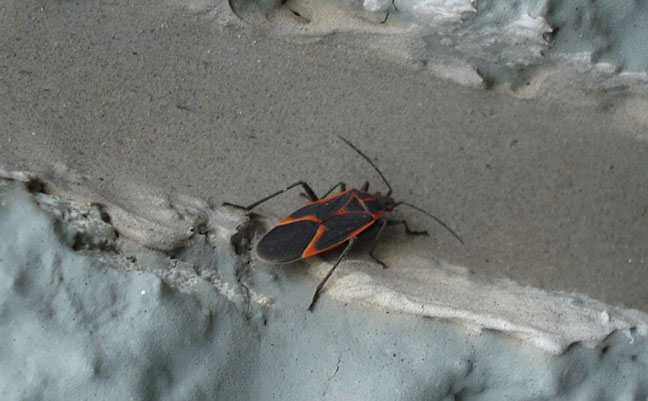
Boxelder bug. (Photo: Dr. Mohammed El Damir, BCE)
• Adults are about 0.5 of an inch long.
• Black with three red stripes on the pronotum.
• The primary host plant of the boxelder bug is the female (seed-bearing) boxelder tree where they feed by sucking plant juices from leaves, twigs and seeds.
• The bugs also been observed on male boxelder, ash and maple trees, and occasionally on strawberries, grasses, and various other plants, but they usually are incapable of full development on these hosts.
• From mid-July through mid-September, they congregate on the trunks of female boxelder trees and the ground near these trees.
• From mid-September to mid-October, they migrate to homes and other types of buildings for overwintering. Only fully grown adults overwinter, while immature stages die by the onset of harsh weather.
• They first congregate on the sunny sides of the building (west, south), and then they hide deep in wall/ceiling voids, cracks, crevices and other protected areas throughout the winter. - Cluster flies
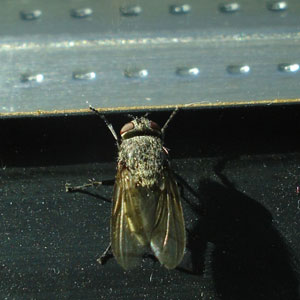
Cluster fly. (Photo: Dr. Mohammed El Damir, BCE)
• They are about 0.25 to 0.375 of an inch long, and are dark gray with uneven light- and dark-gray areas on the abdomen.
• They have golden-yellow hairs on the thorax.
• Larvae develop inside of earthworm bodies.
• The life cycle of cluster flies is completed in 27 to 39 days, depending on the temperature. There are about four generations per summer.
• Adults from late August to early September migrate for overwintering in protected areas, especially on the southern and western sides of a structure. - Harlequin beetles
• At about 0.33 of an inch long, this beetle has several common names, including multi-colored Asian lady beetle, Halloween beetle and orange ladybug.
• It can have multiple colors, with up to 19 black spots — or no spots at all.
• A distinguishing mark is a W or M shape on the thorax.
• They can pinch the skin and cause minor and short-lived discomfort.
• In the U.S., adult beetles invade structures between late September and late October for overwintering.
• They may bunch together in corners of porches, attics, wall voids, door or window frames, or other protected areas.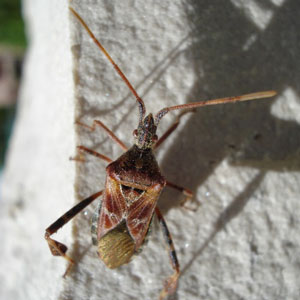
Western Conifer Seed Bug. (Photo: Dr. Mohammed El Damir, BCE)
• In the U.S., there tend to be two generations of harlequin beetles per year; healthy beetles can live up to three years.
- Western conifer seed bugs
• Brown in color, this bug is about 0.75 of an inch long.
• Adults have an inverted white V marking toward the front of each wing, and large hind legs with a flattened, leaf-like area.
• As their name implies, they feed mainly on the seeds of conifer trees.
• They tend to enter buildings at the beginning of cooler weather in the late summer or early fall for overwintering.
• They produce a strong odor when handled, and make a buzzing sound when flying. -
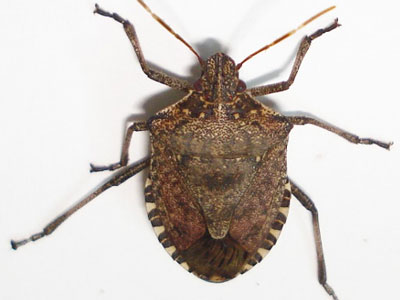
Brown marmorated stink bug. (Photo: Dr. Mohammed El Damir, BCE)
Brown marmorated stink bugs
• About 0.5 of an inch long, and dark mottled brown.
• The last two antennal segments have alternating, broad, light and dark bands.
• The exposed abdominal edges also have alternating dark and light banding.
• Adults overwinter in houses and other protected places.
• When disturbed, the bugs produce a foul odor. - Clover mites
• At about 0.033 of an inch long, these mites are oval, reddish-brown to olive to pale orange; they are sometimes green-brown after feeding.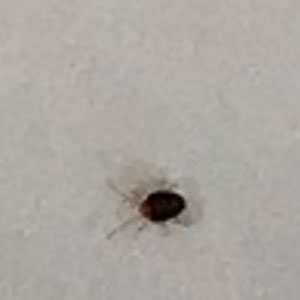
Clover mite. (Photo: Dr. Mohammed El Damir, BCE)
• They have a pair of very long front legs, extending forward at the head.
• They feed and live in clovers, grasses, trees, shrubs, lawns and other plants around buildings.
• Clover mites are considered cool-season mites. Eggs do not hatch below 40°F or above 86°F. Eggs enter a dormant stage during the hot summer, and hatch in early autumn when temperatures fall below 85°F. Adults live one to seven months, and are most active between 50°F and 75°F.
• They infest homes from November through June to overwinter. Most mites overwinter as eggs, but all life stages can be present. -
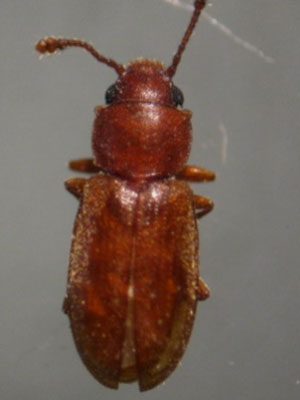
Foreign grain beetle. (Photo: Dr. Mohammed El Damir, BCE)
Foreign grain beetles
• These beetles are reddish-brown and about 0.083 of an inch long.
• They have a three-segmented antennae club, and a tiny knob or bumps on each of the front corners of the thorax.
• They are attracted to light, and are mostly encountered indoors during the early fall. - Yellowjackets
• Typical yellowjackets have black-and-yellow bands on the abdomen.
• The patterns of these bands help to distinguish different species.
• The size of yellowjackets varies depending on the species, but the queens are about 0.75 of an inch long.
• When fertilized, yellowjacket queens seek overwintering sites, such as structures. -
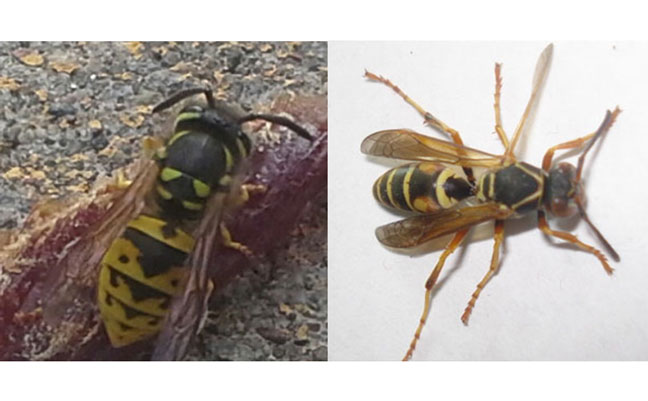
Yellowjacket wasp, left, and paper wasp. (Photos: Dr. Mohammed El Damir, BCE)
Paper wasps
• These wasps are about 0.75 to 1 inch long, and are reddish -brown with a yellow circle.
• They have longer legs and slenderer bodies than yellowjackets and hornets.
• Their abdomens taper at both ends.
• Mated queens are commonly encountered on the sunlit sides of a building in the fall before overwintering in wall voids and attics
TREATMENT TIPS
1. Be prompt. Timing for fall-invading pest control is very important. All pesticide applications and exclusion practices, such as replacing worn outdoor sweeps; sealing all pest entry points; tightening screens, windows and doors; etc., should be made early enough in the fall before fall-invading pests become present on or around a structure. If pesticide treatments are applied in late fall or early winter, customers will complain about live or dead bugs inside living places or overwintering insects already established inside deep wall voids, rendering the exterior pesticide treatment ineffective. However, encountering an extended summer or heavy rains may render the initial liquid treatment ineffective. Accordingly and if needed, another treatment may be needed and/or justified in late September to maintain protection. Retreatment because of weather conditions should be done on a case-by-case basis. Be sure to follow the retreatment intervals specified on the insecticide label.
2. Be efficient. Use a proven long-lasting insecticide with a “knockdown” capability. Residual liquid insecticides are usually used in preventive exterior treatments of fall-invading pests. Depending on the product, these products leave behind long-lasting residual effects for up to 30 days or more and kill fall pests before they make their way indoors.
3. Be thorough. Thorough coverage of pesticide applications is essential for effective fall-invading pests’ management and reducing callbacks. Apply the pesticide carefully, covering all sides of the building. Pay particular attention to the sunlit sides where pests usually congregate. Keep in mind that high entryways around soffits or rooflines provide fall-invading pests, especially cluster flies, access into the attic or crawl space. Accordingly, treat under eaves and all possible entry points under and around rooflines.
4. Be conscientious. Follow all restrictions and requirements on the pesticide label. It is illegal to treat in a manner inconsistent with the label directions. Always treat areas permanently protected from rain, such as under the eaves. If the side is above pervious surfaces (lawn, soil, mulch, etc.), you should treat the whole side, paying attention to entryways.
5. Be a communicator. Manage customer expectations. Let the customer know:
- Dead insects will be seen laying on the ground.
- Bugs do not die right away after treatment. The time needed to kill fall-invading pests depends on the time of the application, species, thoroughness of applications (coverage), rains, and temperature conditions. It could take up to 24 hours to provide 100 percent mortality of fall-invader pests. Therefore, customers should expect to see live bugs after treatment for up to 24 hours.
- Due to extended warm weather, live fall-invading pests can be still seen around the structure after treatment. This is because of the continuous movement of this pest from adjacent areas. However, if the treatment is completed before the bugs are already inside the wall voids, all bugs should die eventually due to exposure.
- If fall-invading pests are already hiding indoors by the time you arrive on the scene, insecticide treatments indoors will not eliminate overwintering pests because it is nearly impossible to treat every hidden area that may be harboring them. Insect light traps (ILTs) can help, but likely will not solve the problem.
In conclusion, to prevent fall-invading pests from entering a structure, apply all exclusion work and pesticide treatments early enough before the adults of fall-invading pests begin moving to the structure; otherwise, insecticide treatments indoors will not eliminate them. Be thorough, using a proven long-lasting residual insecticide, and follow the label directions. Communicate the treatment expectations to the customer.
Leave A Comment